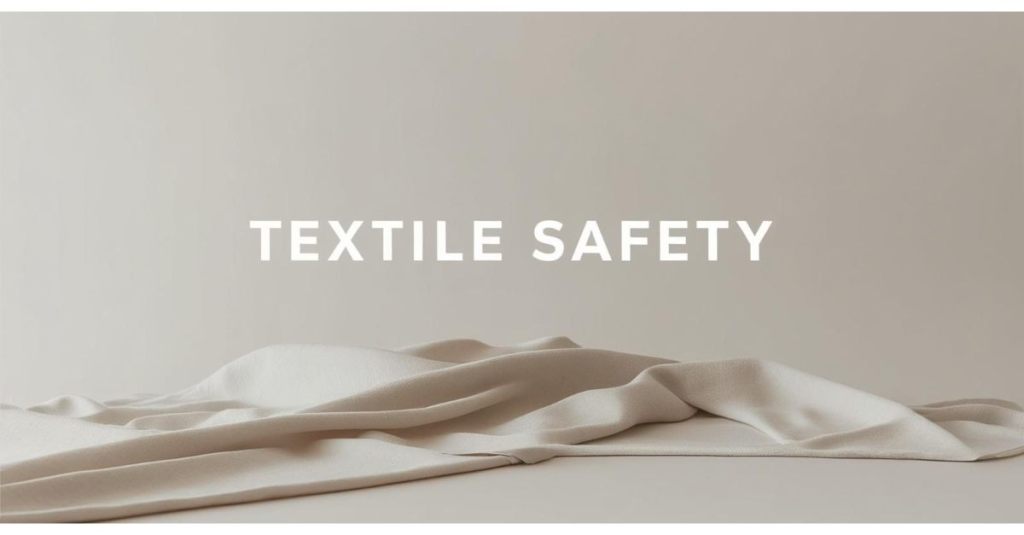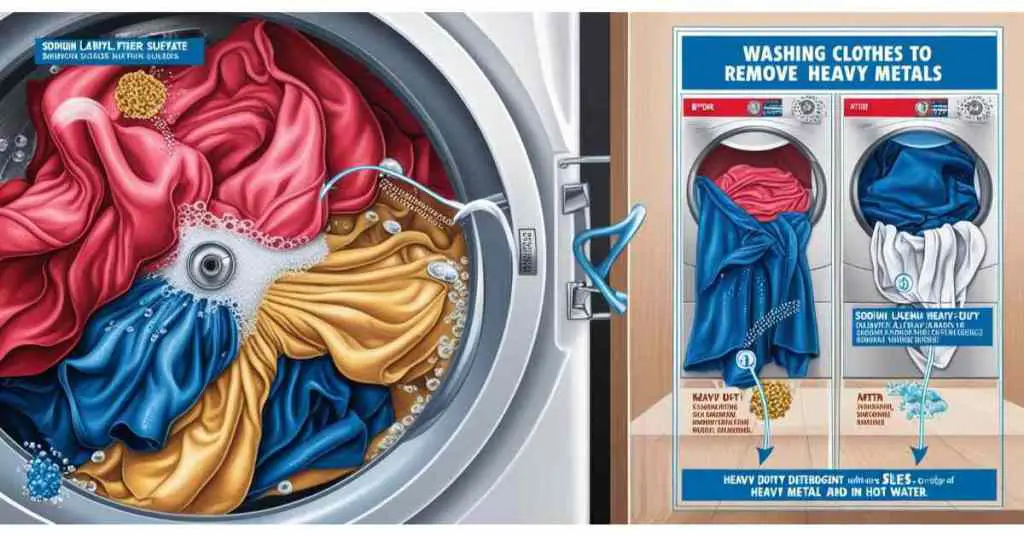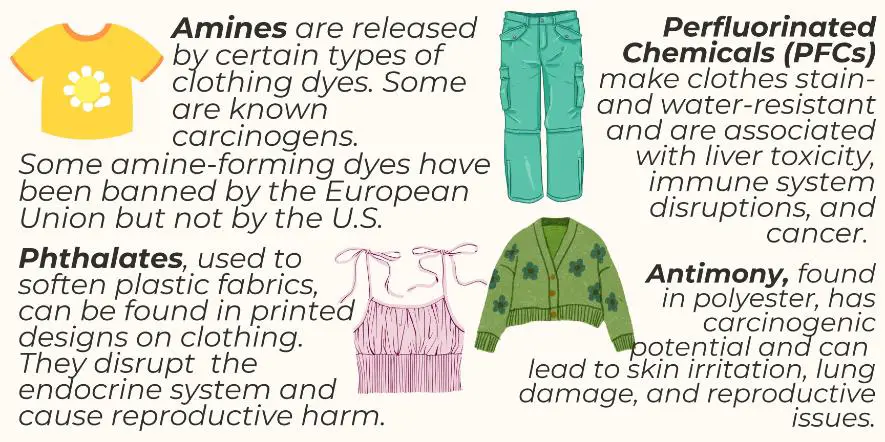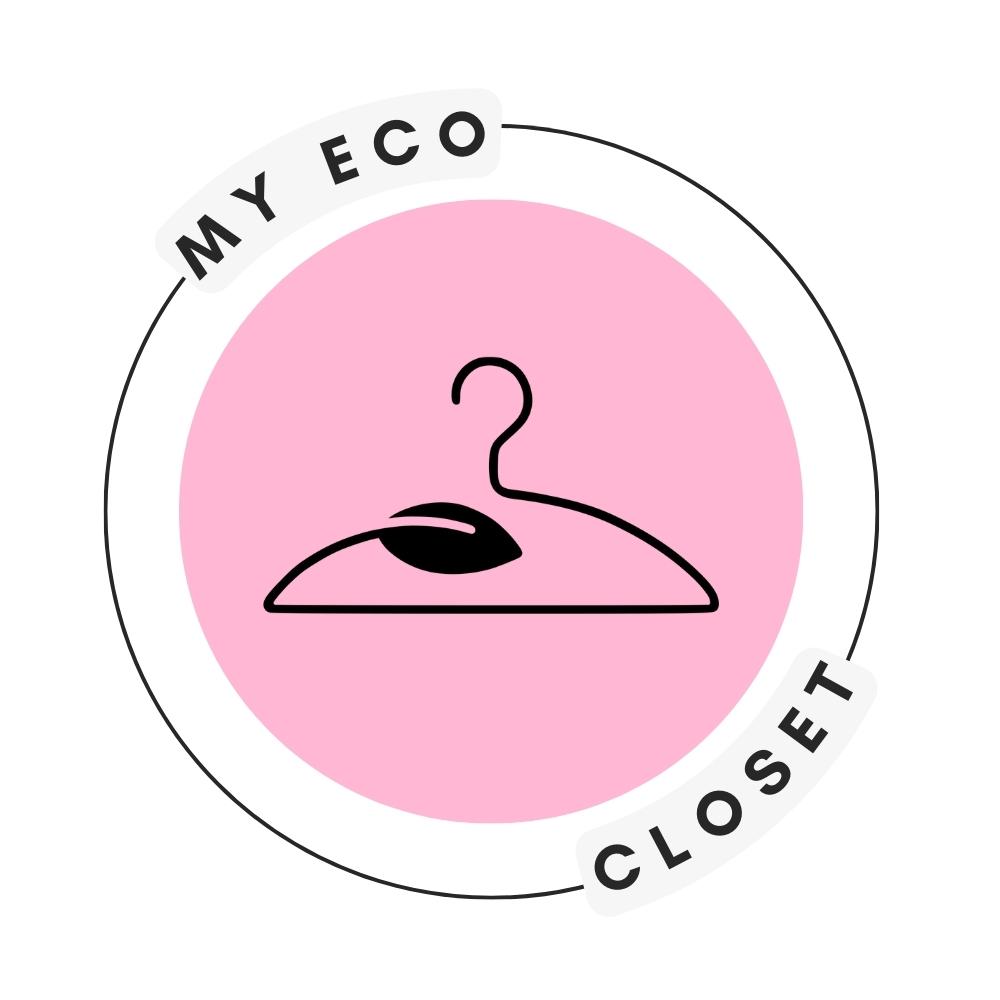Concerned about toxins in your clothing? You’re not alone. Many everyday fabrics, especially from fast fashion brands, can harbor harmful chemicals like heavy metals, formaldehyde, and ‘forever chemicals.’ In this guide, we’ll show you how to effectively wash toxins out of your clothes using both gentle and heavy-duty laundry techniques — helping you protect your health and make more informed choices about what you wear.

A Warning About Toxins in Fast Fashion
Fast fashion giants like Shein, Zaful, Temu, and AliExpress use toxic chemicals that become a permanent part of their clothes. These aren’t minor additives – we’re talking lead, formaldehyde, and phthalates that absorb directly into your skin and can trigger serious health problems.
Think of it this way: once they are embedded in your clothes, trying to wash toxins out of clothes is like attempting to remove the blue from jeans. You might fade it a bit, but it’s there to stay.
That is, while we’ll show you some washing techniques that can help reduce your exposure, they’re not a reliable fix for clothes made with toxic processes.
So, what’s the real solution? Skip the toxic brands entirely. Choose companies that openly share their manufacturing processes and commit to non-toxic materials. Yes, you might spend a bit more, but you’re paying for clothes that don’t put your health at risk.

How to Wash Toxins Out of Clothes: Heavy Metals
Toxins, such as heavy metals like lead, cadmium, and mercury, can accumulate in clothing, especially in garments from low-cost, fast-fashion brands. These metals are often introduced through cheap dyes, embellishments, and finishing processes.
To get rid of them, a somewhat-effective measure is to use a laundry detergent containing stronger surfactants. Surfactants act like magnets, attracting dirt and toxins and helping to wash them away during the rinse cycle.
Look for detergents labeled as heavy-duty or industrial-strength, which often contain surfactants like sodium lauryl ether sulfate (SLES) or sodium dodecyl sulfate (SDS). These are specifically formulated to handle tougher residues, including heavy metals like lead and cadmium.
When washing, be sure to use the longest wash cycle with the hottest water your fabric can handle, and add a bit of Borax to the load for an extra boost in removing these contaminants.
Disclaimer: While washing with surfactants can reduce heavy metal residues, it may not fully remove toxins like lead, which is commonly found in fast fashion garments and can be difficult to eliminate completely from fabric.

Limitations of Washing Techniques
Ultimately, you should know that washing has its limits. Even with the abovementioned technique, getting lead out of your clothes may sometimes be impossible. However, another important consideration is how you handle the clothes before they even touch your washing machine.
Severely contaminated fabrics may require protective handling and disposal, as lead dust can quickly escape from the packaging of your clothes and spread into your living space. This is particularly crucial for items with metallic embellishments, bright dyes, or plastic coatings, which can carry high levels of toxins.
💡 Eco Tip: Instead of relying on washing, avoid purchasing from brands that neglect your health and the well-being of garment workers. Lead exposure from clothing is a serious issue, which is something fast fashion brands refuse to acknowledge.

How to Wash Out Formaldehyde from Clothes: Is it Possible?
Formaldehyde, a carcinogenic that most synthetic fabrics contain, can’t be removed entirely from clothing. According to Herrero et al., when observing both ‘organic’ and conventional maternity clothing, regular washing practices failed to eradicate the chemical (2022). The study detected formaldehyde in 20% of samples — both washed and unwashed.
The reason behind this is that formaldehyde clings closely to the textile fibers. Therefore, removing the chemical would require heavy-duty treatments, which would strip away some layer of the fabric itself.

“Organic” Clothes Can Contain Formaldehyde
The “organic” designation on clothing provides no guarantee against formaldehyde content. Research by Herrero et al. revealed that many organic clothing brands still use formaldehyde in their finishing processes and textile treatments, despite their natural and eco-friendly marketing claims.
To protect yourself from this harmful chemical, look for the OEKO-TEX Standard 100 certification on your clothing tags. This certification system enforces stringent limits on formaldehyde content, with Class I products (designated for infants and children) maintaining a zero-formaldehyde requirement. Higher classification levels permit minimal traces of the chemical, though these remain within scientifically established safety parameters.
A Mitigation Technique for Formaldehyde:
To loosen formaldehyde bonds to some extent, consider using baking soda and 1 cup of distilled white vinegar. Incorporate the solution during the rinse cycle on a cold setting — this is crucial since hot water can seal formaldehyde further into the fabric, making it impossible to wash out.
When mixed together, baking soda and vinegar create a cleaning solution that targets formaldehyde deep within the fabric. The vinegar (which contains acetic acid) helps break apart formaldehyde’s grip on the fabric fibers. Meanwhile, baking soda contributes in several ways:
- Creates an alkaline environment that helps break down stubborn chemical bonds
- Neutralizes unpleasant chemical odors in the fabric
- Works synergistically with vinegar to enhance the overall effectiveness of the treatment
- Helps maintain a balanced pH level throughout the cleaning process

Laundry Stripping: A Heavy-Duty Solution
If you’re looking to thoroughly clean your clothes and remove accumulated residues, the laundry detox method is an effective solution. This process targets build-up from detergents, fabric softeners, sweat, body oils, and even environmental pollutants that cling to your clothes over time. It’s especially useful for cotton, linen, and some durable synthetics that can handle hot water.
A Simple Laundry Stripping Recipe
For a simple detox solution, combine 1 cup of non-toxic laundry detergent, 1 cup of hydrogen peroxide, and 1/4 cup of washing soda. To apply this technique, you can either use a bathtub, sink, or your washing machine:
- Washing Machine Method: Add the detox solution to the detergent dispenser or directly in the drum, then load your clothes and run a normal wash cycle with hot water.
- Bathtub or Sink Method: Fill your container with hot water and dissolve the solution in it. Then, submerge the affected garments and let them soak for 4-5 hours, stirring occasionally to ensure even coverage.

Safety Tips for Laundry Stripping
First and foremost, protect yourself — as you wash toxins out of clothes with the laundry stripping process, always wear gloves. This keeps harsh chemicals off your skin. Secondly, avoid treating delicate fabrics such as Tencel or silk, which are prone to shrinking and fading, with this method. Laundry stripping isn’t suited for those materials, as they can shrink or fade.
Lastly, in the aftermath of the stripping process, make sure to rinse the items thoroughly. To ensure complete decontamination, you can also run the clothes through a regular rinse and drain cycle — without adding any detergent.

Salt Soak: A Low-Impact Decontamination Solution
When it comes to decontaminating delicate fabrics, soaking clothes in a saline solution is quite effective. This method removes unpleasant odors (which are often caused by formaldehyde) at least partially throughout the entire process. The accessibility of salt as a common ingredient makes this decontamination technique practical and accessible – so, make sure to use it frequently.
How to Prepare A Salt Soak
To prepare the soak, dissolve sea salt or table salt in filtered water. The recommended ratio is about 1/4 cup of salt per several cups of filtered water, using enough water to fully dissolve the salt.
To make this soak more heavy-duty, you can mix TSP (tri-sodium phosphate) into hot water, only if the fabric allows it. To check whether it does, you can look at the recommended water temperatures on the clothing label.
As for the next step, fill a bathtub or sink with the saline solution, submerge the contaminated clothing items, and let them soak for a few hours, giving them an occasional stir. After the extended soak, drain the water, and rinse the items thoroughly.
💡 Eco Tip: whether it’s pre-loved or brand new clothes, bedding, or lingerie, we recommend that you soak all your items in the saline solution to set the dyes, prevent color fading, and eliminate bacteria.

If You’re Concerned About Toxins, Avoid Synthetic Fabrics Altogether
When wondering about how to wash toxins out of shein clothes or those from other fast fashion brands, it’s worth reevaluating your priorities. Fashion shouldn’t come at the cost of your health. And when it comes to toxin exposure, synthetic fabrics pose the biggest threats to your well-being.
This is not an exaggeration. When looking at the most common examples of synthetic fibres, we can see that they contain disperse dyes (used to give colors to the fabric), formaldehyde (creates wrinkle-resistant properties), delustrant chemicals (create matte or dull textures on the fabric), and more. All of these garment finishes, chemical solvents, and lead-ridden dyes embody toxins that enter our bodies through clothes over time.
How exactly? Well, on average, a household accumulates around 44lbs of domestic dust a year — 6 of which represent microplastics from synthetic clothes, upholstery, and furniture. Even when we rub synthetic clothes against surfaces, they shed microfibers that pollute the air.
With that said, make sure to avoid the following synthetic materials:
- Polyester
- Nylon
- Rayon
- Polypropylene
- Acrylic
- Spandex

Hidden Toxins in Clothes: What You Need to Know
Even though many of us are conscious of the chemicals in food and cleaning products, the clothes we wear every day often carry hidden toxins that can harm our health. In recent years, studies have found that clothing can be a significant source of lead, phthalates, PFAS (the “forever chemicals”), and other dangerous substances. These toxins can not only irritate your skin but also pose long-term health risks.
For example, in a 2021 study, clothing samples from popular fast fashion brands like Shein, Zaful, and AliExpress were tested for toxic substances. The results were alarming: 38 samples contained dangerously high levels of lead, phthalates, and PFAS, with some items having 20 times the legal limit for these chemicals. These substances can leach into your skin, enter your bloodstream, and potentially cause serious health issues such as cancer, fertility problems, and developmental issues in children.
Given that, here are some of the most concerning toxins commonly found in clothing:

Lead
Lead contamination is possible not only through fast fashion clothing but also accessories. Studies have found that over 25% of fashion accessories from stores like Ross and Burlington contained concerning lead levels, ranging from 0.03% to 1.7%.
Lead enters clothing through several common manufacturing processes, mainly in the form of:
- Metallic decorations and buttons
- Fabric dyes and prints, especially bright colors
- Chemical treatments used to finish garments
- Zippers and other metal accessories
The health consequences of wearing lead-contaminated clothing are serious and well-documented. When absorbed through skin contact or accidentally ingested (particularly by children touching or mouthing clothing), lead can cause permanent damage to the brain and nervous system.
Children may develop learning disabilities and behavioral problems, while adults face increased risks of cardiovascular disease and organ damage.

Phthalates
Phthalates are widespread chemicals in fast fashion, used to make plastics more flexible and add durability to clothing. These chemicals are particularly common in waterproof items, synthetic fabrics, and clothing with plastic prints or decorations.
What makes phthalates so dangerous is their ability to disrupt our hormones. When these chemicals enter our body — whether through skin contact with clothing or breathing in chemical fumes — they can cause serious health problems.
Studies have linked them to fertility issues, particularly in men, while pregnant women exposed to phthalates face risks of birth defects. There’s also growing evidence connecting these chemicals to asthma, obesity, and diabetes.
The risk is especially high for children, who are more sensitive to these chemicals and often put clothing in their mouths. Ironically, items most appealing to kids — like t-shirts with plastic prints, waterproof raincoats, and synthetic sportswear — tend to contain the highest levels of phthalates. This means that the very clothing designed to attract young consumers could be putting them at the greatest risk.
Key concerns around the presence of phthalates in clothes include:
- Direct absorption through skin contact
- Higher risks for children and pregnant women
- Common presence in waterproof and printed clothing
- Links to hormone disruption and developmental issues

PFAS
PFAS, or Perfluoroalkyl and poly-fluoroalkyl substances, are another category of dangerous chemicals that are hiding in our clothes. A recent study by Arnika and IPEN found these toxins in nearly two-thirds (63.8%) of tested clothing, including children’s wear. What makes this particularly concerning is that manufacturers deliberately add PFAS to make clothes water- and stain-resistant.
Moreover, the study found that PFAS are virtually ubiquitous in outdoor gear, as 62.5% of tested outdoor jackets contained PFAS. Some jackets even contained PFOA, a globally banned chemical.
Scientists call PFAS “forever chemicals” for a frightening reason — once they get into your body or the environment, they don’t break down. Instead, they build up over time, potentially causing serious health problems. What makes these chemicals dangerous is that their effects can show up years after exposure, and they can be passed from mother to child during pregnancy.
PFAs can cause fertility issues, organ damage, and cancer. They also wreak havoc on our hormone systems, causing a cascade of health problems, ranging from reproductive damage to immune system dysregulation.

How To Make Better Choices
Our skin is remarkable — it’s our body’s largest organ and a gateway to wellness. By choosing what we wear mindfully, we can nurture our health and feel our best every day. The following trusted certifications now can help us make informed choices:
- OEKO-TEX Standard 100: Guarantees the fabric has been tested and is free from hundreds of harmful chemicals
- GOTS (Global Organic Textile Standard): Ensures organic fiber content and environmentally responsible production from field to finished product
- Cradle to Cradle: Evaluates the complete picture — from material safety to water use and social impact
- Fair Trade: Focuses on ethical production while ensuring clothes are made without harmful chemicals
Switching to healthier clothing doesn’t need to be overwhelming. Start with the basics — the clothes closest to your skin matter most. Think about your everyday underwear, t-shirts, and pajamas. Natural materials like organic cotton, hemp, and linen not only feel better but let your skin breathe naturally.
Remember, small changes add up. Maybe start with that new pair of pajamas or those socks you’ve been meaning to replace. Your skin – and the planet – will thank you for it.

Final Thoughts
We hope that we showed you the impact of toxic fabrics and the importance of making conscious clothing choices. Most importantly, when pondering, “how to wash toxins out of clothes”, think about where you get your clothes from, that is, about the bigger picture. Your purchasing decisions matter, as they define the future of the fashion industry.
By supporting sustainable brands, choosing natural and recycled materials, advocating for stricter regulations, and educating and sharing information with others, we can collectively make a significant difference.
Frequently Asked Questions
How can one detect heavy metal contamination in clothing before washing?
Detecting heavy metal contamination in clothing before washing can be challenging without specialized equipment. Signs may include discoloration, unusual odors, or visible residue. Home testing kits are available, but we recommend professional laboratory testing for accurate results.
What are the health risks associated with exposure to toxins in clothing?
Prolonged exposure to formaldehyde and other toxins in clothing can pose health risks, including respiratory issues, skin irritation, and allergic reactions. Heavy metals can lead to neurological damage, organ toxicity, and developmental disorders. Minimizing exposure is essential for maintaining overall health.
Are there regulations to limit toxins in clothing manufacturing?
Yes, however, not always. Regulatory inspections for limiting the presence of toxic substances typically apply only to sustainable brands. Garments shipped from overseas often bypass these inspections. Ethical clothing, however, is frequently certified organic by organizations like OEKO-TEX, guaranteeing adherence to rigorous safety standards.


I couldnt agree more! Synthetic clothes gave me and my daughter cancer! This is so informative, please keep up the good work.